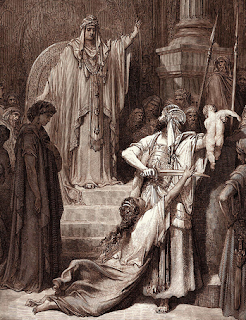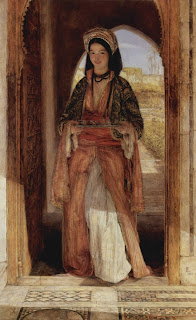Two years ago my Valentine's Day post was about polyamory in folktales. This year, once again, I put up a poll on Twitter to see what love-related folktale theme I should blog about, and the winner was Tricksters in Love. I adore trickster tales, and I'm currently working on a whole book of them, so here are some of the stories I found about tricksters falling in love.
Side note:
Trickster relationships are very rarely easy or harmonious. Probably for the obvious reason that tricksters themselves are very rarely easy or harmonious characters; breaking rules, tricking others, and going outside the ordinary is within their nature. So, the following tales might not be what people would describe as romantic...Links in the titles.
How Ananse the Spider got Aso in marriage (Ghana)
Ananse (or Anansi) the Spider is one of the world's most well-known tricksters. His wife, Aso Yaa features into many of his stories; sometimes she helps him, but more often they mutually trick each other. Aso is a clever lady, and she can certainly hold her own against Ananse. In their 'origin story', she is married to an abusive and jealous man who keeps her hidden from everyone else. Ananse uses trickery to approach her in secret, and eventually he gets her pregnant. When the truth comes out, Aso is returned to her community, and marries Ananse. All in all it is a fun story, except for the end, where they sacrifice their first baby for some reason. (I tend to blatantly disregard that part.)
Anansi and Miss Flame (Jamaica)
In another story Anansi falls in love with Fire herself, and Fire flirts with him (he is "drawn to her like ants to sugar"). However, when she comes to visit him at night, she shows up as a "full grown woman" rather than a nice little flame, and Anansi flees from her. Fire burns his house down. In other versions, he puts her out with water.
Coyote dances with a star (Klamath)
Coyote falls in love with a star and wants to woo her. At first he sings to her, but she doesn't respond, so he climbs up a mountain and jumps up to the sky to dance with her. They dance around and around the night sky but Coyote gets exhausted and scared, and eventually the star lets go. Coyote falls back down to earth, creating a great big crater.
Coyote and the Whirlwind Woman (Mandan-Hidatsa)
Coyote falls in love with a strange woman who claims that no one wants to marry her because she moves camp too often. Coyote claims he loves to move and travel, so they marry. However, when it is time to move camp, the woman turns out to be the Whirlwind, and she drags and tosses Coyote along. After a few moves, he leaves her with Groundhog's help.
Brother Rabbit's Courtship (African-American, USA)
This is a story from one of Joel Chandler Harris' Uncle Remus collections, also rewritten by Julius Lester. Br'er Rabbit falls in love with one of the daughters of Miss Meadows, and she likes him too, but they are both very awkward, and she does not want to marry until she gets a sign through some love magic. So, Br'er Rabbit manufactures a sign himself, and they get happily married. Cute story.
Jack and the King's Girl (Appalachia, USA)
A classic tale type where a foolish young man does everything wrong following someone else's advice. However, here we have a princess who never laughs, and she is the one talking to Jack every day - so the whole story comes off as Jack doing silly, funny things just to make the princess laugh.
Zaynab the Coney-catcher and Mercury Ali (
1001 Nights)
Okay, so this one is full of problematic elements, but if you leave those out, it is a pretty fun story. Zaynab is a second-generation trickster; the chapter preceding hers is about how her mother, Dalilah the Wily, made a fool of the entire city guard of Bagdad multiple times. Mercury Ali is an infamous trickster in his own right, who comes to Bagdad and has a run-in with Zaynab. They immediately like each other, and start a very intense prank war as foreplay to their marriage. In the end, Ali marries three other women as well as Zaynab, and they have their adventures written down for posterity.
Kuzunoha (Japan)
One of the most famous kitsune (fox spirit) legends is about a kitsune named Kuzunoha who falls in love with a mortal man who saves her life. Her son, Abe no Seimei, inherits some of her powers, and becomes a famous magician who speaks the language of animals. Eventually he discovers his mother's secret and she leaves the family, but her husband searches for her and finds her again.
Nasreddin Hodja's perfect wife (Middle East)
A short and poignant tale about the trickster and wise fool Nasreddin seeking the perfect wife around the world... only to find out that the perfect woman won't marry him, because she is looking for the perfect husband.
The First Love of Khodja Nasruddin (Temur Zulfiqorov)
This is not technically a folktale, but rather a very beautiful short story from a Tajik author about how the young Nasreddin Hodja first falls in love with the forbidden daughter of a very rich man. He manages to visit her, but they can't run away together, and eventually he is exiled into the world to become the traveling wise man, fool, and trickster he is known as.
If there are other trickster love stories you'd like to see on this list, let me know in the comments! Happy Valentine's Day!



























